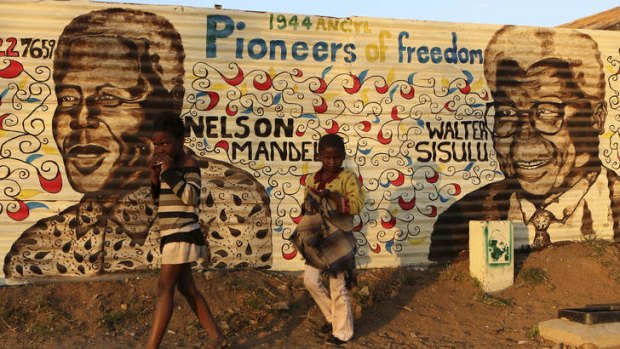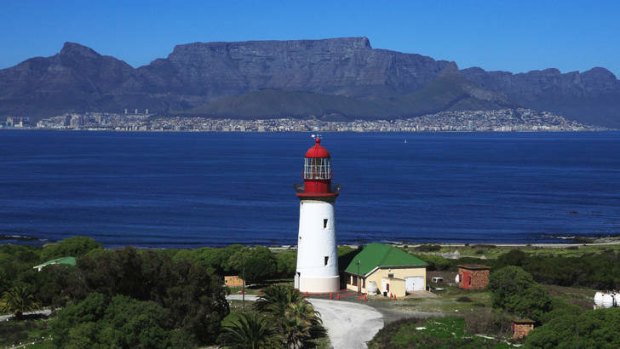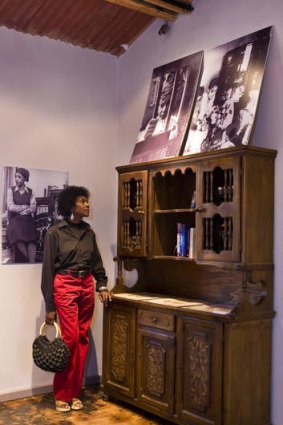
A Soweto mural of Nelson Mandela and fellow anti-apartheid activist Walter Sisulu, painted by Siyabonga Mbola.Credit: Reuters
Rachel Olding traces the life of a legend through the monuments to his legacy.
Pedalling through the muddy, potholed backstreets of Soweto, it's hard not to notice Nelson Mandela everywhere. Vibrant images of the former South African leader are graffitied on the crumbling brick walls of Africa's largest township. Streets and museums carry his name. Busloads of noisy schoolchildren offload at Mandela House on Vilakazi Street and scream with delight as they move through the one-storey brick house where the leader of the anti-apartheid movement lived in the late 1940s with his wife Winnie and their two children. His indelible spirit pulses through daily life in South Africa and manifests in the smiles and waves that Sowetans extend as we ride past on rickety pushbikes.
"There used to be a lot of hatred here," says our young tour guide, Nkululeko, who leads bike tours around the gritty streets of Soweto from Lebo's backpacker hostel. "But Mandela instilled a lot of morals in us. He showed us we don't need to fight, we don't need to be angry. We can laugh and smile and welcome everyone."
Few people in the world have inspired and energised a nation like Nelson Mandela, who is held in almost deity-like regard by the diverse and conflicted people of South Africa.
The evidence of such reverence spreads far and wide with a trail of museums, monuments, cultural exhibits and spectacular grassroots art that is worthy of a trip to the African nation all on its own. And with his health at a critical point, Mandela is in the front of South Africans' minds - and to millions more people around the world, for that matter - as never before.
While few during my visit will talk openly about the 94-year-old's ailing condition at the time of writing - in part because of a traditional respect for the living and in part because of sheer adulation in a country that puts his face on its banknotes - there is little doubt that Mandela's passing, will see a surge in domestic and international tourism.

Robben Island, Cape Town.Credit: Getty Images
One South African newspaper recently reported that people in Qunu, the rural village in the Eastern Cape where Mandela grew up, were preparing to rent rooms in their homes on the assumption there would be a big influx of visitors following his death. The town is home to the Nelson Mandela Museum, one of three museums essential for those wanting to trace the footsteps of the great leader.
"Whenever he is sick, it seems to touch a nerve in so many people," the museum's marketing manager, Nokuzola Tetani, says. "People who travel along the highway see the signage and they just take a turn off randomly. They seem to share this feeling and concern with us."
Qunu and the foothills that rise from the banks of the Mbashe River in Mvezo is where Mandela spent the happiest moments of his childhood, he wrote in his autobiography, The Long Walk to Freedom. Inside the museum, several wings are packed with bright displays tracing the anti-apartheid struggle and the world its central character grew up in, including the Rivonia trial that landed him in prison and a huge photo that renders people still for several minutes: wife Winnie Madikizela-Mandela standing isolated on the courthouse steps after his sentencing.

Nelson Mandela Museum.Credit: AFP
The Apartheid Museum in Johannesburg is a larger, slicker and more visceral exhibition that tells incredibly powerful stories from the country's most troubled era. At the other end of the spectrum is Mandela House in Vilakazi Street, where buskers perform outside restaurants and boys hawk anything with Mandela's face on it. "It was the opposite of grand," Mandela said of the dwelling in The Long Walk to Freedom. "But it was my first true home of my own and I was mightily proud. A man is not a man until he has a house of his own."
Each exhibit and monument is part of a join-the-dots experience as you travel further across South Africa and the scattered collection of vignettes slowly builds into a rich picture of an even richer life.
The journey takes a decidedly darker tone on Robben Island, the brutal sea-girt prison that stands stoically on a 518-hectare rocky outcrop in Table Bay set against Cape Town's beautiful jagged mountains. The harshness of both the ocean and the concrete structure that housed Mandela for 18 of his 27 years as a political prisoner is obvious and oppressive.
It only makes the stories of the former prisoners-turned-tour guides even more incredible. Such was the sense of hope and energy on Robben Island that when Mandela emerged from prison in 1990 to lead South Africa to democracy, he preached forgiveness and equality, not revenge and black empowerment.
In 1999, Robben Island was acknowledged by UNESCO's World Heritage Committee for its symbolisation of the "triumph of the human spirit".
"At times we were so busy we forgot we were prisoners," says Thulani Mabaso, an imposing man who spent six years of an 18-year sentence on Robben Island for his part in the bombing of the South African Defence Force building. "We were always organising, preparing, planning. We planned the country while we were behind bars. We just had that kind of spirit and determination and togetherness, led by Mandela."
Even after Mandela transferred from Robben Island to Pollsmoor prison, information was smuggled and the prisoners on Robben Island were following his orders.
On the day Mabaso was released in 1991, he was ushered straight onto a business class flight - his first-ever plane trip - to the first African National Congress meeting in Durban, where he met the country's future leaders and was treated like a king.
Years later, when it was proposed that Robben Island be transformed into a museum, the prisoners made an undertaking that they would be the ones to pass on the important history, which is why a handful remain as tour guides. "Mandela taught us that we will forgive but never forget," Mabaso says. "After everything that was done to him, he still preached the gospel of reconciliation and forgiveness."
Far away from the walls of museums and prisons, however, is where Mandela's legacy really comes alive in South Africa. The subtle tributes in streets, parks, buildings and everyday conversations with South Africans have a profound impact on me. The vibrant graffiti displays of Sowetans convey a working-class adulation that a museum display doesn't, and a "selfie" taken with a giant Madiba statue in Nelson Mandela Square in the Johannesburg suburb of Sandton, or the Voting Line statue at Donkin Reserve in Port Elizabeth, will take pride of place above most others.
In Johannesburg, I marvel as we pass over the Nelson Mandela Bridge between Braamfontein and Newtown, a landmark with no connection to the former president but an architectural masterpiece with dramatic brush strokes that evoke the sweeping change Mandela bought to South Africa.
Each city is rich with these smaller tributes. Sharp-eyed travellers will pick up references scrawled on walls, and asking everyday South Africans about their beloved Madiba becomes a trip highlight. The answer is always different.
"He's like a father to me," says one middle-aged man hawking jazz CDs in a Cape Town market.
It is in these smaller nooks and crannies that Mandela's passing may create the biggest waves. While museums and major landmarks will no doubt experience a surge in popularity, questions remain over the impact it will have on national sentiment. One blunt caller to a radio show recently said, "All hell will break loose".
The black South African from a poor township was voicing a quietly held view that Mandela's passing may unleash not just grief and celebration, but also a violent rage against the poverty and inequality that still exists in South Africa and has risen to the fore recently in the Marikana mine massacre and other major crimes.
The theory goes, according to BBC Africa correspondent Andrew Harding, that even from his hospital bed Mandela exerts "some sort of restraint on a turbulent nation".
Yet many are adamant that the welcoming arms and friendly smiles pointed out by our Sowetan tour guide, Nkululeko, won't disappear after Mandela: It will simply be the next chapter in a country's history made all the more interesting by Mandela.
"I think we have managed to prepare ourselves to move forward," Mabaso says at Robben Island. "We will make sure we hold on to those values and we keep moving on his path. And then we will have more people coming to the island than ever before."
The writer travelled to South Africa courtesy of South Africa Tourism.
TRIP NOTES
GETTING THERE
Qantas has a fare to Johannesburg for about $1730 low-season return from Sydney, including taxes for the non-stop 14-hour flight; see qantas.com.au. Melbourne passengers pay about the same and fly Qantas to Sydney to connect.
GETTING AROUND
Travelling between the provinces is best done with a hire car. However, crime rates in South Africa are high. Basic security precautions, such as keeping your doors locked and windows closed, are necessary, as carjackings are not uncommon. There is a world-class domestic airline network. South African Airways is the principal carrier. See flysaa.com.
SEE+DO
- Apartheid Museum, Johannesburg, see apartheidmuseum.org.
- Robben Island Museum, Cape Town, see robben-island.org.za.
- Mandela Museum, see nelsonmandelamuseum.org.za.
- Nelson Mandela House, Soweto, see mandelahouse.co.za.
- Nelson Mandela Square, Johannesburg, see nelsonmandelasquare.co.za.
MORE INFORMATION
Sign up for the Traveller Deals newsletter
Get exclusive travel deals delivered straight to your inbox. Sign up now.